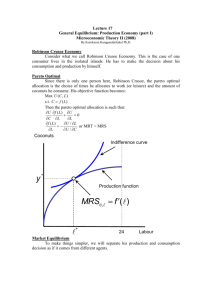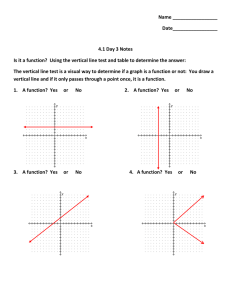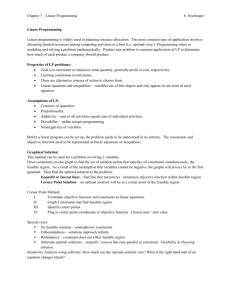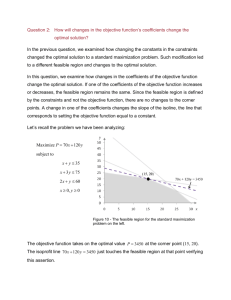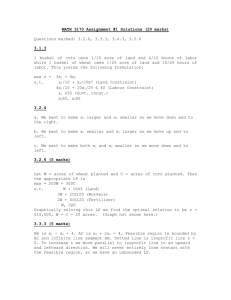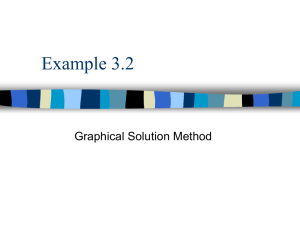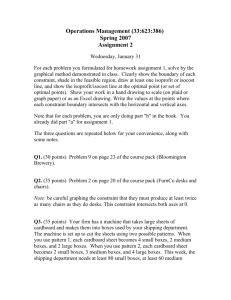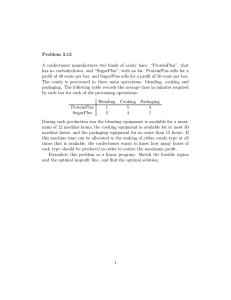Economics II Homework Solution: Budget Lines & Equilibrium
advertisement
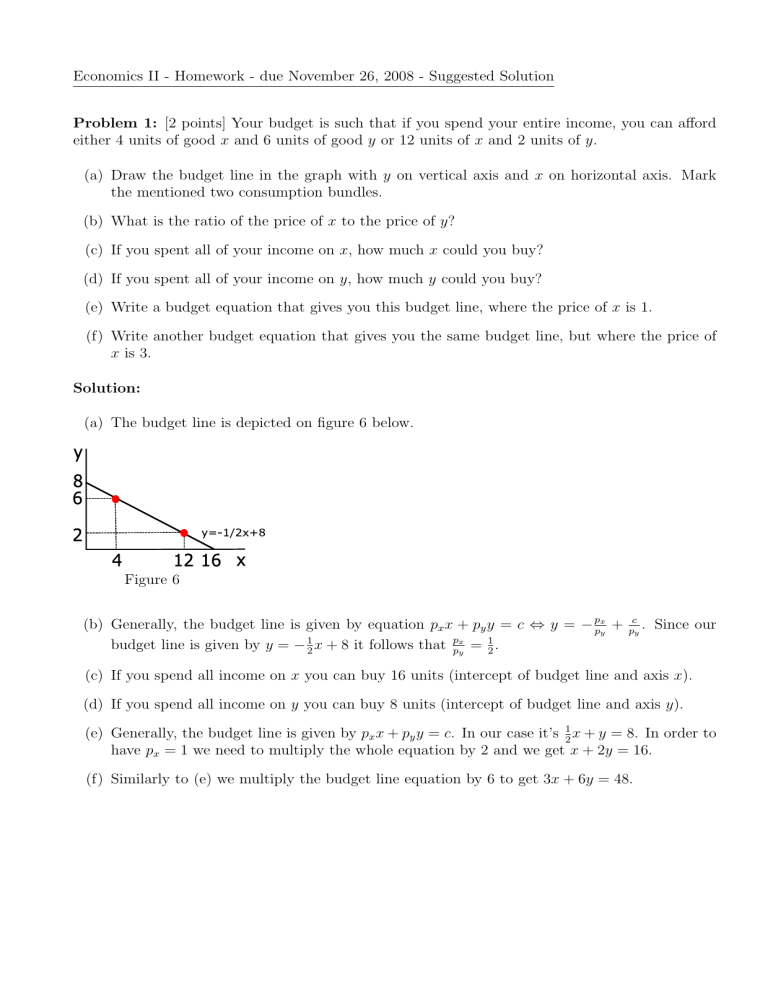
Economics II - Homework - due November 26, 2008 - Suggested Solution
Problem 1: [2 points] Your budget is such that if you spend your entire income, you can afford
either 4 units of good x and 6 units of good y or 12 units of x and 2 units of y.
(a) Draw the budget line in the graph with y on vertical axis and x on horizontal axis. Mark
the mentioned two consumption bundles.
(b) What is the ratio of the price of x to the price of y?
(c) If you spent all of your income on x, how much x could you buy?
(d) If you spent all of your income on y, how much y could you buy?
(e) Write a budget equation that gives you this budget line, where the price of x is 1.
(f) Write another budget equation that gives you the same budget line, but where the price of
x is 3.
Solution:
(a) The budget line is depicted on figure 6 below.
Figure 6
(b) Generally, the budget line is given by equation px x + py y = c ⇔ y = − ppxy +
budget line is given by y = − 12 x + 8 it follows that ppxy = 12 .
c
.
py
Since our
(c) If you spend all income on x you can buy 16 units (intercept of budget line and axis x).
(d) If you spend all income on y you can buy 8 units (intercept of budget line and axis y).
(e) Generally, the budget line is given by px x + py y = c. In our case it’s 21 x + y = 8. In order to
have px = 1 we need to multiply the whole equation by 2 and we get x + 2y = 16.
(f) Similarly to (e) we multiply the budget line equation by 6 to get 3x + 6y = 48.
Problem 2: [3 points] Consider a following two-consumers (A,B) and two-goods (x,y) economy.
The utility function of the first consumer is
uA = 2xA + y A
and his endowment is ω A = (4, 0). The second consumer has the following utility function
uB = min{xB , 2y B }
and endowment ω B = (0, 3).
1. Find the competitive equilibrium and graph it in the Edgeworth box.
2. Find Pareto efficient allocations and graph them in the Edgeworth box.
Solution:
1. Competitive equilibrium consists of equilibrium prices px , py and allocations {xA , y A }, {xB , y B }.
Consumers solve following optimization problems:
Consumer A:
Consumer B:
max 2xA + y A
{xA ,y A }
s.t. xA + py A ≤ 4
max min{xB , 2y B }
{xB ,y B }
s.t. xB + py B ≤ 3p
where we choose good x to be numeraire and denote py = p.
In Consumer A’a optimization problem we replace inequality constraint with equality and
plug it into the function to be maximized:
Consumer A:
max 2(4 − py A ) + y A
yA
F OC : −2p + 1 = 0 ⇒ p =
1
2
In Consumer B’s optimization problem it must hold that xB = 2y B .
Consumer B:
max min {xB , 2y B }
{xB ,y B }
s.t. 2y B + py B = 3p
3
1
since p = , we get: y B =
2
5
and from budget constraint: xB =
6
5
Finally, we determine xA and y A from market clearing conditions:
6
14
=
5
5
12
3
yA + yB = 3 ⇒ yA = 3 − =
5
5
xA + xB = 4 ⇒ xA = 4 −
Hence, the competitive equilibrium is: {px , py } = {1, 1/2}; {xA , y A } = {14/5, 12/5}; {xB , y B } =
{6/5, 3/5}.
2.
The set of Pareto efficient allocations is given by:
xA
2
and y B = 3 − y A
xA and y A = 1 +
xB = 4 − xA
Problem 3: [2 points] The short-run production function of a competitive firm is given by f (L) =
6L2/3 , where L is the amount of labor it uses. The cost per unit of labor is w = 6 and the price
per unit of output is p = 3.
(a) Plot a few points on the graph of this firm’s production function and sketch the graph of
the production function. Draw the isoprofit line that passes through the point (0,12), the
isoprofit line that passes through (0,8), and the isoprofit line that passes through the point
(0,4). What is the slope of each of the isoprofit lines? What is are the profits from production
plans on each of the isoprofit lines? Highlight the part of the isoprofit line through (0,4) that
consists of outputs that are actually possible.
(b) How many units of labor will the firm hire? How much output will it produce? If the firm
has no other costs, how much will its total profits be?
(c) Suppose that the wage of labor falls to 4, and the price of output remains constant at p = 3.
On the graph, draw the new isoprofit line for the firm that passes through its old choice of
input and output. Will the firm increase its output at the new price? Explain why, referring
to your diagram.
Solution:
(a) Points on the production function: (0, 0); (1, 6); (5, 17.53); (10, 27.85); (50, 81.43).
Profit function: π = yp − wL
Isoprofit line: y =
2.
π
p
+
wL
,
p
in our case: y =
π
3
+ 2L. Hence, all isoprofit lines have the slope
Through point (0,12): y = 12 + 2L → π/3 = 12 → π = 36
Through point (0,8): y = 8 + 2L → π/3 = 8 → π = 24
Through point (0,4): y = 4 + 2L → π/3 = 4 → π = 12
Production function
Isoprofit lines
(Possible outputs is the part of the isoprofit
line below the production line)
(b) maxL π = 18L2/3 − 6L
FOC: 12L−1/3 − 6 = 0 ⇒ L = 8 ⇒ y = 6 ∗ 82/3 = 24 ⇒ π = 3 ∗ 24 − 6 ∗ 8 = 24.
(c) Now, w = 4 and p = 3. Old choice of input and output is (8, 24) and the profit is π =
24∗3−8∗4 = 40. Therefore, the corresponding isoprofit line is given by y = πp + wL
= 40
+ 4L
p
3
3
At the new wage the firm will increase its output. It will happen because of opportunity to
increase the profit.
